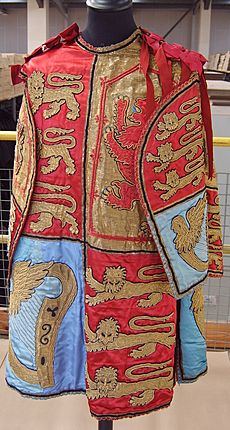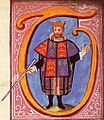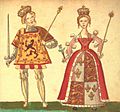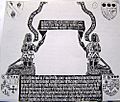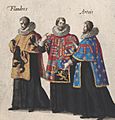Tabard facts for kids
A tabard is a special kind of short coat. People wore them a lot in Europe during the late Middle Ages (around the 1300s to 1500s) and the early modern period (from the 1500s to 1700s).
Tabards were usually worn outdoors. They often had no sleeves, or sometimes short sleeves or shoulder pieces. Many tabards were just everyday clothes, even work clothes. But some very special tabards had a family's coat of arms (a unique design or symbol) sewn onto the front and back. These special tabards are still worn today by officers of arms, who are officials that deal with coats of arms and ceremonies.
In modern British language, the word "tabard" is also used for a lightweight, open-sided top. In America, this is often called a "cobbler apron." Workers in places like kitchens, cleaning services, and hospitals wear them as protective clothing. People who need to be seen easily, like construction workers, also wear bright, high-visibility tabards. Sometimes, drummers in marching bands wear tabards to protect their uniforms from their instrument straps.
Contents
Tabards in History
Tabards became popular in Europe during the Middle Ages. They were simple, practical coats. Many people, especially workers, wore them because they were easy to move in.
Special Tabards for Heralds
The most famous type of tabard is the one worn by officers of arms, also known as heralds. These officials were very important in medieval times. They helped organize tournaments, deliver messages, and keep track of coats of arms.
Their tabards were brightly colored and covered with the coat of arms of their king, queen, or noble family. This showed everyone who they worked for and how important their message was. Even today, heralds in countries like the United Kingdom still wear these traditional, colorful tabards during special events and ceremonies.
Modern Uses of Tabards
While the original tabard style is mostly for heralds now, the idea of a simple, protective overgarment lives on.
Protective Clothing
Today, many people wear tabards as a type of protective clothing. These are often made from lighter fabrics and are open at the sides. They are easy to put on over regular clothes to keep them clean. You might see them worn by:
- Chefs and kitchen staff
- Cleaners
- Healthcare workers
High-Visibility Tabards
Another modern use is for high-visibility clothing. These tabards are usually bright yellow or orange and have reflective strips. They help people be seen in low light or busy areas, making them safer. For example, you might see them worn by:
- Road workers
- Emergency services
- People directing traffic
- Cyclists or runners
Tabards for Musicians
Some percussionists in marching bands wear tabards. These help protect their uniforms from the straps and equipment they use to carry their drums and other instruments.
Images for kids
-
Thomas Hawley, Clarenceux King of Arms, depicted in his tabard on a grant of arms of 1556
-
Gelre Herald to the Duke of Guelders, c.1380
-
James I, King of Scotland 1406–1437, and his wife Joan Beaufort
-
Heraldic tabards worn at the funeral of Albert VII, Archduke of Austria, in Brussels in 1622
-
A pursuivant wearing his tabard "athwart". A drawing by Peter Lely from the 1660s.
-
St John the Baptist Wearing the Red Tabard of the Order of St John (1671) by Mattia Preti
See also
 In Spanish: Tabardo para niños
In Spanish: Tabardo para niños


